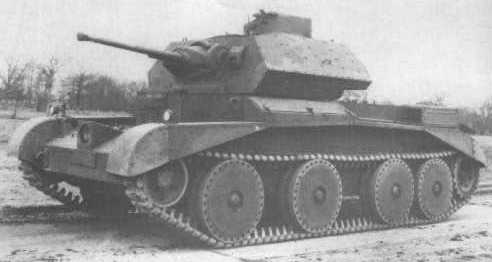
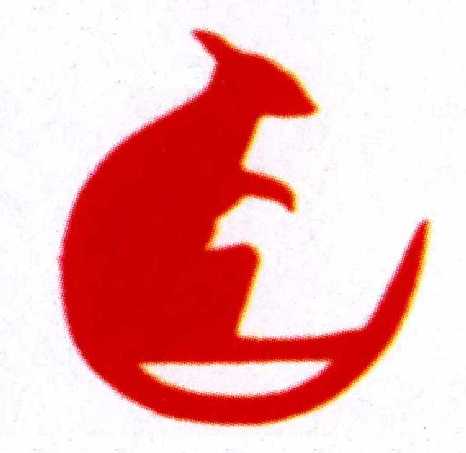
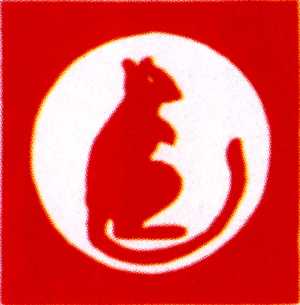
Equipment Used By the Tank Regiments
During the war the most dramatic developments took in the field of Armoured Fighting Vehicles. The tank developed from a slow moving poorly armed fighting vehicle into massive metal monsters that ruled the battlefield. What follows is a brief summary of the Tanks that were used by the various Armoured and Cavalry Regiments that served in the Division during the Second World War. The details of the Armoured Cars can be found in the Armoured Car Equipment Page. Due to the relatively large numbers I have had to restrict the information on each.
Tanks
It is worth noting prior to the start of the Second World War the British Army saw the tanks prime role as infantry support, as demonstrated by the heavily armoured Matilda I, which only had a 0.5-in Machine Gun and moved at a maximum speed of 5-8 mph. However, the Tank Corps insisted that it also be equipped with fast moving, light tanks, which could strike at the enemies rear and these became know as "Cruiser Tanks" as a comparison to the vessels used in naval equivalent strategy. Wherever possible I have highlighted which category the tanks were placed by the army.
Matilda II (A12) Infantry Tank:
The Matilda II and the earlier Matilda I were developed as infantry tanks based upon the experiences of the First World War. It is said that the Matilda I got its name when General Sir Hugh Ellis, while watching a prototype, commented that it waddled like Matilda the Duck, a comic strip character of the time.
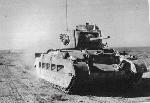
It was designed to accompany the infantry and therefore needed to withstand heavy anti-tank fire. The Matilda II was designed by the Woolwich Arsenal; using heavy cast armour and a 2-pdr gun in a turret. It had a four man crew and was powered by twin diesel engines. Production began in late 1938 and a few reached France in time to give a good account of themselves during Battle of Arras, when a certain Erwin Rommel's HQ was nearly over run. Their success was because of their immunity to German gunfire, with even an 88mm having to work hard to knock a Matilda out and led to the Germans rethinking their anti-tank strategy and weapons.
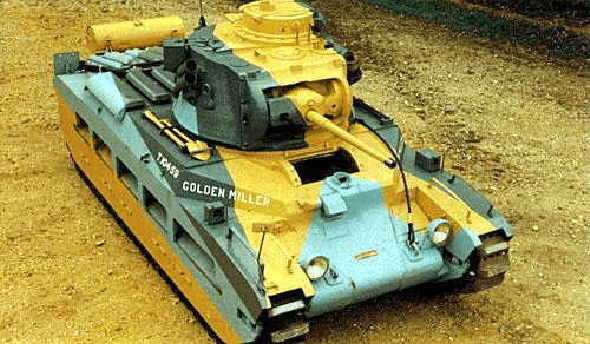
The Matilda II, was used to greatest effect in the Western Desert, where the normal Italian and German anti-tanks could not touch them. This had to be left to the famous 88mm. Because of its resistance to anti-tank fire, it was wrongly used as a cruiser tank, for which it did have the speed. Attempts to fit a 6-pdr did not prove a success, since the turret could not accommodate the larger weapon. It last saw action at El Alamein in October and November 1942. The Matilda II was known by its crews as the "Queen of the Battlefield" because of its ability to withstand so much fire. The picture above shows a Matilda II in typical Desert Camouflage.
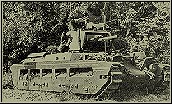
As with other British tanks a CS (Close Support) version was built, which mounted a 3-in Howitzer with HE capability. These were known as the Matilda III. For the battle of El Alamein some Matildas were converted to carry flail, in order to clear the minefields for the other tanks. These were called "Scorpions".
Matilda II , Specification
|
Armament |
Armour |
Weight |
Length (m/ft in) |
Width (m/ft in) |
Height (m/ft in) |
Powerplant |
Speed (Km/h/Mph) |
Crew |
|
1 x 2-pdr & 1 x 0.303" or, 7.92mm BESA MG |
78 -14 mm (3.1-0.6in) |
29.6 tonnes |
5.61/ 15ft 11in |
2.59/ 8ft 6in |
2.52/ 8ft 3in |
2 x AEC 6 cyl diesels, 174 bhp |
25/16 |
4 |
| Matilda II Infantry Tank | |
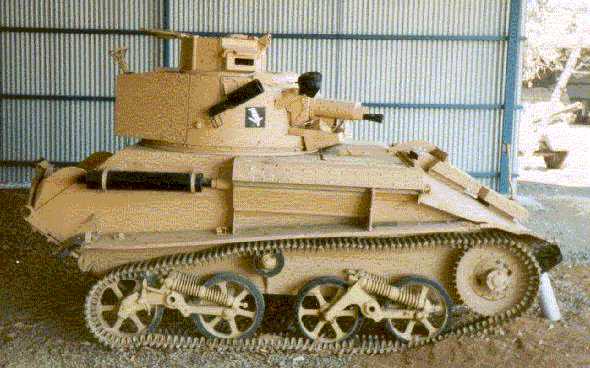
The MK VIB & C Light tank was designed by the Vickers company, as was the mainstay of the British Armoured strength during 1939 to 1940. Unfortunately, it was often used as a main battle tank, often with terrible results. Both models carried a 0.303" Machine gun, but B model also featured a 0.5" water cooled Machine Gun, whereas the C model had a 15mm BESA Machine gun. Armoured and Light tank units used these tanks in squadrons of three and it saw service in Belgium, France, North Africa, Greece and Crete. Later on some were converted in to Quad anti-aircraft tanks, to provide air defence for the tank units in battle or on the move. Approximately 1180 were built.
MK VI, Specification
|
Armament |
Armour |
Weight |
Length (m/ft in) |
Width (m/ft in) |
Height (m/ft in) |
Powerplant |
Speed (Km/h/Mph) |
Crew |
|
1 x 0.5" & 1 x 0.303" MGs or, 1 x 11mm & 1 x 0.303" MGs |
14 mm (Max) |
5.28 tonnes |
3.94/ 12ft 11in |
2.06/ 6ft 9in |
2.24/ 7ft 4in |
6 cylinder gasoline |
56/35 |
3 |
| British Light VIB Tanks |
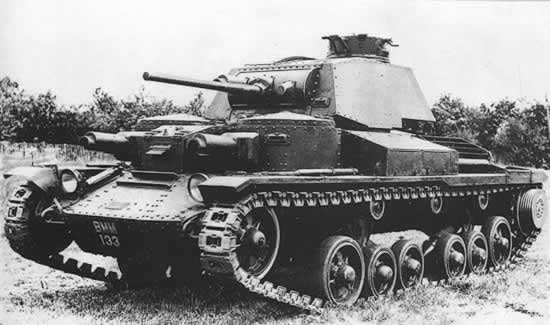
Properly known as the Cruiser tank MK I the A9 was a lightweight development of the MK III Medium tank. Powered by a commercial engineer it was developed to meet 1934 proposal for a fast Cruiser (medium) Tank for the tank regiments of the Royal Armoured Corp. It was powerfully armed for its day, it had two machine guns in independent turrets in the front hull, plus a 2-pdr (40mm) main armament. The tank was only disadvantaged by its slow speed and thin armour, but it was used extensively in France and the Western Desert. The driving and fighting compartment were together. Each of the MG gunners was on either side of the driver in separate turrets. The steering brakes were mounted on the outside of the rear sprockets. This allowed them to cool faster. 125 were built and some saw service in France, 1940, with 1st Armoured Division where the weakness of the armour and is slowness became apparent. It then saw service is North Africa with 2nd and 7th Armoured Divisions. It was withdrawn from service in 1941.

The main disadvantage of British tanks in the early stages of the war was that 2-pdr had no HE or smoke capability. Although it was considered that the machine guns could perform an anti-infantry role, the lack of smoke was considered a serious problem. Whilst all British tanks of the period were issued with smoke candles for self-concealment, they had no way of projecting smoke cover. To fulfil this role the CS (Close Support) version was developed, with a 3.7-in Howitzer replacing the 2-pdr, it could fire a 4.77kg smoke shell instead. A HE shell was also produced, but was in short supply in North Africa. When 3 RTR went to Calais in May 1940, they got there only to find that the HE shells, for their A9 CS tanks, had been left on the dockside in the UK.
A9, Specification:
|
Armament |
Armour |
Weight |
Length (m/ft in) |
Width (m/ft in) |
Height (m/ft in) |
Powerplant |
Speed (Km/h/Mph) |
Crew |
|
2-pdr, plus 3 x 7.65mm MGs & 3.7-in Howitzer, plus 3 x 7.65mm MGs for the CS Version |
14 mm (Max) |
13 tonnes |
5.79/ 19ft |
2.4/ 8ft 2.5in |
2.65/ 8ft 4in |
6-cyl AEC Type A1791 150hp @ 2,200 rpm |
40/45 Range 240Km/150 miles |
6 |
| A9 Cruiser MK I and A10 Cruiser MK II Tanks |
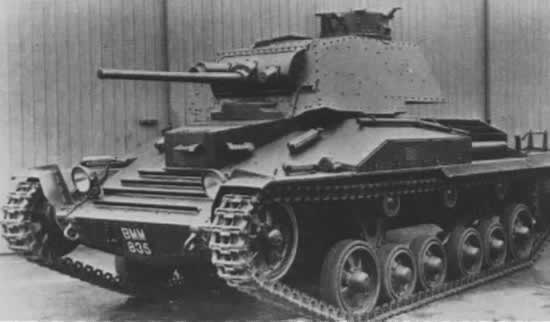
The A10 Cruiser tank was a development of the A9, with the same boat shaped "hull" and slow motion suspension. It was intended that the A10 should rectify some of the shortcomings of the A9, such as area or protection on the front plate, which was increased to 30mm. This increase was gained by bolting the addition plates to the existing A9 hull, which was the first time this technique had been used with British armour. However, the speed dropped to about half that of the A9, due to the additional weight, which meant that the A10 was too slow to really be a true cruiser tank. As part of this the twin "sub-turrets" were removed which allowed for more room for ammunition. Both the A9 and A10 were consider stopgap vehicles as it had been decided in 1937 that a tank should be developed based upon the designs of Walter Christie. It had the same turret and shaped hull, but with the additional armour bolted on the hull and turret. Gunner controlled the elevation of the gun with his shoulder. 31 were sent to France with the 1st Armoured Division and then it saw service in North Africa. A total of 175 MK II or MK IIA were built.

As with the A9 a CS (Close Support) version was developed in parallel with the main tank. It was armed with a 3.7-in Mortar (Howitzer) OQF MK I, which was a single shot weapon and could only fire smoke. In battle the CS versions would accompany the Squadron Headquarters of the tank regiment protecting the gun tanks with smoke screens for them to manoeuvre. Only 30 CS versions were built.
Although the armour for both the A9 and A10 was comparatively thin, by being sloped this increased the protection given a feature that was copied in later tanks.
A10, Specification:
|
Armament |
Armour |
Weight |
Length (m/ft in) |
Width (m/ft in) |
Height (m/ft in) |
Powerplant |
Speed (Km/h/Mph) |
Crew |
|
2-pdr, plus 2 x 7.92mm BESA MGs & 3.7-in (94mm) Howitzer, plus 2 x 7.92mm BESA MGs for the CS Version |
30 mm (Max)
|
14.4 tonnes |
5.79/ 18ft 4in |
2.4/ 8ft 2.5in |
2.65/ 8ft 4in |
6-cyl AEC Type A1791 150hp @ 2,200 rpm |
26/16 Range 240Km/150 miles |
5 |
A13 - Cruiser Tank MK III and MK IV:
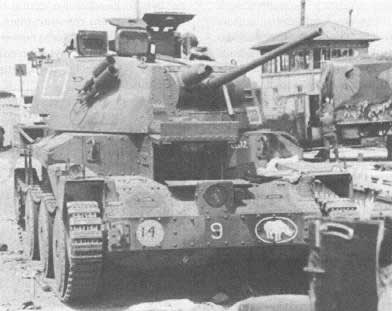
The Cruiser tanks MK III and IV (A13), were inspired by the Soviet BT tank based on the ideas of Walter Christie. The A13 was built to be faster than the previous cruiser tanks and was in fact almost twice as fast as the A9. It was the first tank to be fitted with an engine governor to limit the speed and avoid mechanical complications. However, once in the field the governors were usually suppressed by the crews to allow faster running speeds. It was built in three versions, the MK I, MK II and CS. The main difference between the MK I (65 built) and MK II (655 built) was that the latter to the new cruiser standard of having 30mm armour in the vulnerable area. Despite the extra weigh the MK II suffered no significant drop in speed. Some were issued to the 1st Armoured Division in France after which it served in 7th Armoured Division in Western Desert 1940-41, were additional armour plate was also bolted added. It was also used for training purposes.
The MK III (above) was built with a standard A10 turret while the MK IV (left) was built with a redesigned turret, having a hexagonal appearance and space armour. The latter was another first for British tanks. The CS version, of the A13 MK IV, was again fitted with a 3.7-in Mortar (Howitzer) OQF MK I which was a single shot weapon and could only fire smoke. This was rapidly becoming a disadvantage and this was the last tank to be fitted with it.
A13, Specification:
|
Armament |
Armour |
Weight |
Length (m/ft in) |
Width (m/ft in) |
Height (m/ft in) |
Powerplant |
Speed (Km/h/Mph) |
Crew |
|
A13 (MK III) 2-pdr, plus 7.65mm or 7.92mm BESA MG |
30 mm (Max)
|
14 tonnes |
6.02/ 19ft 9in |
2.44/ 8ft 6in |
2.65/ 8ft 4in |
Nuffield Liberty 340hp @ 1,500 rpm |
48/30 Range 145Km/90 miles |
4 |
| A13 (MK IV) 2-pdr, plus 7.65mm or 7.92mm BESA MG & 3.7-in (94mm) Howitzer, plus 1 x 7.92mm BESA MG for the CS Version |
30 mm (Max)
|
14.76 tonnes |
6.02/ 19ft 9in |
2.44/ 8ft 6in |
2.65/ 8ft 4in |
Nuffield Liberty 340hp @ 1,500 rpm |
48/30 Range 145Km/90 miles |
4 |
Valentine - Infantry Tank MK III:
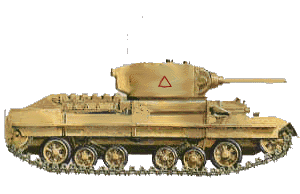
The Valentine tank was submitted for approval to the War Office on 14th February 1938, hence the code name. The first ones were ordered from Vickers in July 1939. They were originally called Infantry Tank MK III and reached service in May 1940, with production finally ending in early 1944. They served in North Africa, Madagascar, Burma and the Pacific Campaign, plus in Russia too. The Soviets used 1300 Valentines on the Eastern Front. 8275 were built in Britain and a further 1420 in Canada.
The Valentine used 6 road wheels on each side, in two 3-wheeled bogie units. The turret varied between the different models, with early models having a 2-man turret and the later ones a 3-man version, but it was always cramped. The main armament was the normal 2-pdr, but this progressed to a 6-pdr and a 75mm. The Soviets replaced the 2-pdr with a 76mm gun, which made the turret even more cramped.
When its role as a tank was over many were re-used, firstly as the basis for the Bishop Self-Propelled Gun, with a 25-pdr mounted on a large "box" on top and later as the Archer Self-Propelled 17-pdr anti-tank gun. Some were also used as the basis of bridge-layers, flame-throwers and swimming tanks. It is as bridge-layers that the Valentine mainly served with the Division.
Valentine, Specification
|
Armament |
Armour |
Weight |
Length (m/ft in) |
Width (m/ft in) |
Height (m/ft in) |
Powerplant |
Speed (Km/h/Mph) |
Crew |
|
1 x 2-pdr or 1 6 pdr or 1 x 75mm, plus 1 x 7.92mm BESA MG (omitted on some 6-pdr tanks) |
60 Max |
16.26 tonnes |
5.41/ 17ft 9in |
2.62/ 8ft 7in |
2.26/ 7ft 5in |
AEC or GMC diesel |
25/16, with a range of 145 km (90 Miles) |
3 or 4 |
Note:
MK 1, 2, 4, 6 & 7 had a 2-pdr in 2 man turret, MK 3 & 5 had a 2-pdr in 3 man turret, MK 8, 9 &10 had a 6-pdr in 2 man turret, MK 11 had a 75mm in 2 man turret| Valentine Tank |
A15-Cruiser Tank MKVI (Crusader):
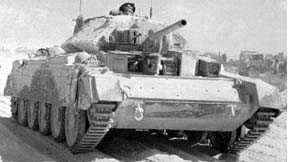
The Cruiser MKVI or A15 Crusader was developed as a heavy Cruiser tank, by Nuffield Mechanisation, using the Christie suspension becoming popular at that time. It was based on the earlier Covenanter tank, but had a longer hull and had an auxiliary turret in the hull mounting a 7.92mm BESA machine gun. Along side this turret was a similar, non-rotating, structure which was the driver's vision hood. The auxiliary turret was the differentiating feature of the MK I and MK II versions, with the MK II version having increased armour on hull front and turret front. The turret was of diamond section, with the sides being sloped to deflect shot and the original armament was a 2-pdr gun, which was eventually upgraded to a 6-pdr later on.
The Crusader suffered a number of problems, with the compressed air steering and transmission and it was found that the auxiliary turret had very poor ventilation and was later removed along with the driver's machine gun.
The tank first went into battle in Egypt in 1941 during Operation Battleaxe, but was outclassed by the German tanks due to its 2-pdr gun. Late in 1942 versions fitted with the 6-pdr appeared in time for El Alamein, without the auxiliary turret and the larger gun restricted turret space so the crew was reduced to three, with the commander acting also as gun loader. It was used in Tunisia, but was withdrawn from service at the end of the North African campaign. However, its service was not over as it was then converted to fulfil a number of other roles such as a Command or OP version with a dummy gun and extra radio equipment, a AA version with single 40mm BOFORS (AA MK I) or twin 20mm Oerlikons (AA MK II & III) in a modified turret, a ARV, with no turret, but with a crane and winch fitted, a Gun Tower, which towed a 17-pdr and carried its crew and 40 rounds of ammunition. A CS (Close support) version fitted with a 3-in howitzer was also produced, capable of firing Smoke and High Explosive. It was the MK I, MK II & MK II and the AA MK II & MK III versions that served with the Division.
 |
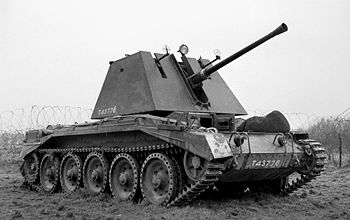
|
Crusader, Specification
|
Armament |
Armour |
Weight |
Length (m/ft in) |
Width (m/ft in) |
Height (m/ft in) |
Powerplant |
Speed (Km/h/Mph) |
Crew |
|
1 x 2-pdr (MK I & II) or 1 6 pdr (MK III) or 1 x 3-in Howitzer (CS) plus Co-axial 7.92mm BESA MG & 1 x 7.92mm BESA MG in Auxiliary Turret (later removed) |
40 mm Max, MK I, 50 mm MK II onwards |
19.3 tonnes |
5.96/ 19ft 8in |
2.64/ 8ft 8in |
2.23/ 7ft 5in |
Liberty V-12 petrol, 340 bhp |
44/27.5, with a range of 320 km (200 Miles) |
5 (for MK I or MKII with aux turret) 4 without aux turret 3 for MK III with commander acting at the loader. |
| Crusader Tank |
The US General Stuart M2, or Honey as the British called it was very versatile light tank. It first entered production in 1941 as the M2A4 model, which soon became the M3 Light Tank. The M2A4 was supplied to the British in Egypt in 1941, but since the M3 and later M5 models were substantially the same they were all given the same name, but the British did give each variation a different number. They were; Stuart (M2A4), Stuart MK 1 (M3), Stuart MK 2 (M3 Diesel), Stuart MK 3 (M3A1), Stuart MK 4 (M3A1 Diesel), Stuart MK 5 (M3A3), Stuart MK 6 (M5) and Stuart MK 7 (M5A1).
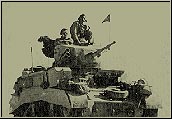
The main difference between the M2A4 and the M3 was increase armour to protect against air attack, which resulted in changes to the suspension to cope with the extra weight better. The main difference between the M3 and the M5 was the increase in the thickness of the armour, a change of engine, plus a few other minor changes. The weaponry of all Stuarts were basically the same, with a 37mm gun and co-axial machine gun in the turret and a hull mounted machine gun, too. It became known as the "Honey" by the British because of its reliability and handling.
It served in the British Army in many roles such as a Cruiser Tank, in a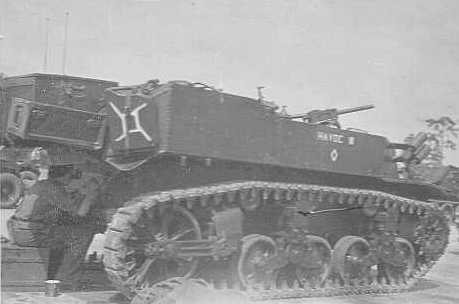 Reconnaissance role, as an armoured screen and as an armoured escort. Some were
used as AOP's by the artillery (especially in the Desert and Italy), while later
in the war some had their turrets removed and becoming troop carriers or gun
tractors. Also many used in Reconnaissance Troops in Armoured Regiments in NW
Europe and Italy were modified this way too, as it was found that the high
profile of the tank with the turret made it a easy target. So the turret was
removed it and substituted with a locally made hatch and a 0.5-in Browning for the tank commander to operate, as
shown to the right.
Reconnaissance role, as an armoured screen and as an armoured escort. Some were
used as AOP's by the artillery (especially in the Desert and Italy), while later
in the war some had their turrets removed and becoming troop carriers or gun
tractors. Also many used in Reconnaissance Troops in Armoured Regiments in NW
Europe and Italy were modified this way too, as it was found that the high
profile of the tank with the turret made it a easy target. So the turret was
removed it and substituted with a locally made hatch and a 0.5-in Browning for the tank commander to operate, as
shown to the right.
Stuart, Specification;
|
Armament |
Armour |
Weight |
Length (m/ft in) |
Width (m/ft in) |
Height (m/ft in) |
Powerplant |
Speed (Km/h/Mph) |
Crew |
|
M3A3 - 1 x 37mm, plus 2 x 0.30-in Machine Guns |
37 mm Max |
14.4 tonnes |
5.03/ 16ft 6in |
2.51/ 8ft 3in |
2.29/ 7ft 6in |
Continental 7 Cyl radial, Petrol, 250 bhp @ 2400rpm |
58/36, with a range of 112 km (70 Miles) |
4 |
|
M5A1- 1 x 37mm, plus 2 x 0.30-in Machine Guns |
64 mm Max |
15.38 tonnes |
4.83/ 15ft 10in |
2.29/ 7ft 6in |
2.39/ 7ft 10in |
Dual Cadillac V-8 petrol, 220 bhp @ 4000rpm |
58/36, with a range of 112 km (70 Miles) |
4 |
| Stuart (Honey) Tank | |
| This shows a M3A1 version | This shows a Recce (Cut-Down) version and a normal M5 version |
The Grant tank was once called the tank that saved the British in North Africa, as it arrived in time effectively combat the German armour.
The story of its use in the British Army started back in July 1940 the US drew up plans for the production of a new medium tank, the M2A1, but it was recognised that any new tank should be armed with a 75mm gun. It was pointed out that it was no possible to fit a 75mm gun into the turret of the proposed M2A1 as it was designed only to hold a 37mm gun and as no turret has as yet been designed to mount a gun of this size. However, in the previous year an experimental tank with a hull mounted 75mm gun had been built and it decided this was a good starting point for the new design. Based upon this a design was produced in which the 75mm gun was mounted in a traversing sponson on the right side of the hull, while a 37mm turret was to be retained on top of the hull, offset to the left. The design was produced at great speed and by March 1941 it was complete, with the first pilot models being available three weeks later.
Meanwhile, in June 1940 the British purchasing commission went to the US to buy tanks for the British Army, hoping the US would agree to produce British designs, but the US Government was adamant that their tank facilities were needed to US designs only. This mean that if the British were to buy tanks in the US they would have to be US designs, with the latest being the M3 Light (Stuart or Honey) and the M3 Medium. The British bought both, but with one modification to the latter, which was to have the turret was altered to contain the tanks radio and the machine gun in the cupola on the turret was removed to improve the silhouette.
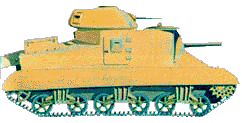
In October 1940 the contracts were signed and the first deliveries started in early 1942 and went straight to North Africa and were used in May 1942 in the Gazala battle. Since the British gave their tanks names the modified M3 became the General Grant and the unmodified M3 became the General Lee. They received a mixed reception, with them proving reliable, but with the 75mm gun mounted in the hull this meant the hull had to be exposed to the enemy to fire it, thus preventing the tank adopting a hull down position. Nevertheless the 75mm gun gave the British crews parity with their German opponents and also the capability to fire HE shells at last as well as armour piecing shot from the larger gun.
The tank feature to main weapons, a hull mounted 75mm howitzer, offset to the right hand side in sponson, with a 37mm gun in the turret offset to the left of the tank. When it was eventually replaced by the M4 Sherman it went on to serve in Burma and the Pacific theatres, but a few were modified to carry search lights and became known as Canal Defence Light (CDL) Tanks in the European theatre of action. These had the turret replaced by spotlight. Some used to illuminate night crossings of Rhine and Elbe in 1945 and some of this variant were sent to Far East but never used. Other versions include Grant Command, some of which had turret gun replaced with dummy gun and extra communications equipment was added; Grant Scorpion III, with the 75mm gun removed and an anti-mine device added and Grant Scorpion IV, which was effectively the same as Scorpion III but with 2nd Bedford engine added.
Grant, Specification
|
Armament |
Armour |
Weight |
Length (m/ft in) |
Width (m/ft in) |
Height (m/ft in) |
Powerplant |
Speed (Km/h/Mph) |
Crew |
|
1 x 37mm (turret) plus 1 x 75mm gun in Hull) plus Co-axial 7.92mm BESA Machine Gun |
63.5 mm Max |
27.2 tonnes |
5.64/ 18ft 6in |
2.72/ 8ft 11in |
3.12/ 10ft 3in |
Wright Whirlwind R975, 9 cylinder petrol, 340 bhp @ 2400 rpm or Two Leyland E148/E149 Diesel engines with 95 hp each |
42/26, with a range of 193 km (120 Miles) |
6 |
| Grant Tank | |
The M4 Sherman if probably one of the best known tanks of the Second World War. It was developed from requests by the British for a tank with a 75mm gun in a rotating turret, instead of the sponson used on the Grant.
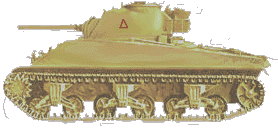
Two designs were considered, one using a cast hull and the other a welded hull, with both basing the engine and running gear on the M3 Grant. A welded hull model of the M4 was produced as the M4A1 and production began in February 1942, for delivery to the British. The basic Sherman has a turtle backed hull and a cast turret. The driver sat in the front left with an assistant driver/machine gunner alongside him. The engine was an air-cooled aircraft radial mounted in the rear of the hull. The drive shaft then passed along the floor to the transmission unit in the front, where it drove the track drive sprockets. The turret mounted a 75mm gun and a co-axial machine gun, with the gunner on the right, the commander behind him, with the loader/machine gunner on the left. The early Shermans have the characteristic of having rounded corners to the top of the front hull, while the latter one had "squarer" corners.
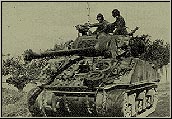
The 75mm gun soon became obsolete and the British re-gunned some of their Shermans with the 17-pdr anti-tank gun, which became known as the Firefly (Left). This gave them a method of knocking out the heavier German tanks at longer range. The Americans used a 76mm version to achieve the same. To accommodate the larger gun the coaxial machine gun was removed and a larger counter weight fitted to the back of the turret. Towards the end of the war the later models also had the hull machine gun removed so more of the larger 17-pdr ammunition could be carried. To provide protection against infantry some tank commanders often mounted a 0.30" Browning or BESA machine gun on the turret.
All models of the Sherman caught fire easily, which earned them the nickname of "Ronsons" by their crews and "Tommy Cookers" by the Germans, but it was the mainstay of the British Armoured Division until almost the end of the war, when the Cromwell had fully replaced it. A Diesel version was also produced which did not catch fire so easily, but this was not widely available.
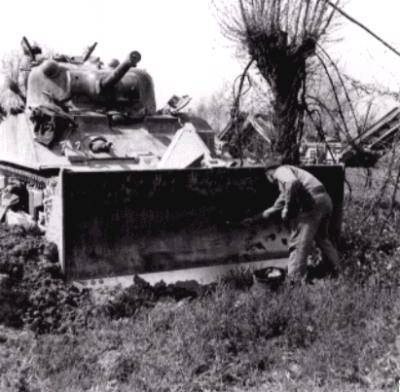
Mine clearing flail versions were developed and used, along with the DD (Duplex Drive) version, which swam ashore on D-Day, during the Normandy Invasion. Other Shermans had bulldozer blades fitted to the front to allow the Armoured Regiments to deal with objects that might otherwise need the assistance of the Royal Engineers. This proved useful in demolishing some of the hedges in the Normandy 'Bocage', roadblocks and filling anti-tank ditches. They saw wide service in Italy as well as in Northern Europe. One is pictured right.
The below pictures show some of the over various versions of Shermans.
An AOP version was provided to the artillery, which in order to accommodate the extra radios needed for this role, had the 75mm gun replaced with a wooden dummy one, though the hull and co-axial machine guns were retained.
Sherman, Specification
|
Armament |
Armour |
Weight |
Length (m/ft in) |
Width (m/ft in) |
Height (m/ft in) |
Powerplant |
Speed (Km/h/Mph) |
Crew |
|
1 x 75mm plus 2 x 0.30-in Machine Guns Firefly - 17-pdr and 1 x 0.30 in Machine Gun |
108 mm Max |
31.75 tonnes |
6.05/ 19ft 10in |
2.62/ 8ft 7in |
2.74/ 9ft |
Ordnance RD-1820 9 cylinder radial petrol, 487 bhp @ 3000 rpm |
40/25, with a range of 200 km (125 Miles) |
5 (3 for Firefly) |
| Sherman Tank | |
| M4 Version | Firefly, with barrel disruptive camouflage |
The Cromwell tank was introduced in 1944 and was also known as the A27 or Cruiser MK VIII. It started life in 1941 when Leyland Motors suggested a tank design using an adapted Rolls-Royce Merlin aero-engine, of Spitfire, Hurricane and Lancaster fame. At that time there was a short of the Rolls-Royce engines (called a Meteor for this application) so two designs were progressed. One using the Liberty engine became the Centaur and the Meteor engine version became the Cromwell. Once Meteor engines were available the Centaurs were fitted with them and became Cromwells, too. Production began in January 1943.
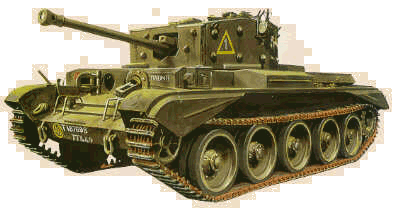
The Cromwell used the Christie suspension system and with the Meteor engine, it had a very impressive turn of speed and great manoeuvrability. The new engine proved more reliable that some of the earlier engines, which gave the Cromwell a good reputation. The engine was fitted with a governor, but as with the A13, this was usually decommissioned by the crew, to give a higher top speed. (NB. I once spoke to someone who had served in the Guard's Armoured Division and they were definitely not allowed to touch the governor!) Originally, the armament was to be the 6-pdr, but this was changed to a new British designed 75mm gun, which could use American ammunition, which made supply easier in the European theatre of operations.
The tank went through eight marks including an AOP version, for artillery observers, which retained the 75mm gun and was equipped with two extra No. 19 radios in the turret and one in the hull, but as they carried no trained gunner, it was not that effective. To achieve this some of the BESA machine gun ammunition bins were removed, which meant the crew had a limited quantity to defend themselves against infantry attack. The 75mm gun was operational including the ammunition which was kept in the radio operator's seat and in bins outside the turret basket in the corners of the compartment. The very nature of an AOP tank meant that it could assist the leading units of the Division and remain intact at the same time. The tank was commanded by an Artillery surveyor, usually a Major or Captain, who brought two radio operators with him, the remaining operator was from my the Armoured Brigade HQ Squadron. The crew of an AOP could call on the artillery regiment to mark a target with pink smoke to guide the Typhoons from 2nd Tactical Air Force or the artillery could bombard the target directly. There was an ARV version with no turret, but with a crane and winch for recovering damaged tanks and guns. A Command Tank version was also made which at regimental and squadron level were normal gun tanks with extra radios in the front gunner's compartment as per the AOP version. However, one of the Cromwells assigned to 22nd Armoured Brigade was designated as the Brigade command tank and had the turret stripped out and the gun replaced with a tree trunk. The turret was then welded to the hull so that it could not turn. Additional radios were fitted and operated by Royal Signals. This was the Brigade command tank which went right through to the end of the war. An identical vehicle was also used for the 7th Armoured Division HQ command tank.
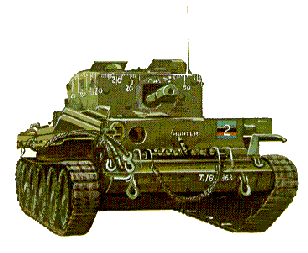
The MK I was originally produced in 1943 with a 6-pdr and 2 machine guns. The other major variations were MK II, with wider tracks and hull machine gun removed and 75mm gun, MK III and MK IV which were the Centaur MK 1 & MK 3, refitted with the Meteor engine, MK V had a welded hull, MK VI was the close support (CS) version (left) with a 95mm (3.7-in) Howitzer, MK VII was a MK IV with added armour and wider tracks and the MK VIII was a MK VI with added armour and wider tracks. It was in the CS version that Royal Marine Assault Squadrons landed on the Normandy beaches to bombard the German defences as close range.
The markings on the CS version (pictured left) are to allow easier target sighting by accompanying troops or from the turret.
Cromwell, Specification;
|
Armament |
Armour |
Weight |
Length (m/ft in) |
Width (m/ft in) |
Height (m/ft in) |
Powerplant |
Speed (Km/h/Mph) |
Crew |
|
Cromwell:- 1 x 6-pdr (MK I) or 1 x 75mm (MK III-V) or 1 x 3.7-in Howitzer (CS/MK VI & VIII) plus 1 or 2 x 7.92mm BESA MGs |
63 mm max, hull, 76 mm max turret |
27.5 tonnes (MK I) 28 tonnes (MK VII) |
6.4/21ft |
3.05/10ft |
2.51/ 8ft 3in |
Rolls-Royce Meteor V12, 600 bhp |
61/38, with a range of upto 278 km (173 Miles) |
5 |
| Cromwell Tank | |

A version of the Cromwell was also produced with a larger turret and 17-pdr gun, which was know as the Challenger (A30). The Cromwell chassis was lengthened by adding another road wheel, with a large turret being designed to accommodate the breech and recoil system of the 17-pdr gun. Although ungainly and with poor performance, it did work and was approved for production in February 1943 with 200 being built.
It was mainly used by the Armoured Reconnaissance Regiments, of Armoured Divisions, such as the 8th Hussars, who used it from the autumn of 1944. Due to its high silhouette it was vulnerable as a battle tank so it was generally used as Tank Destroyer, with 1 being issued to each troop. Some units preferred to use Sherman Fireflies in preference to the Challenger.
Challenger, Specification;
|
Armament |
Armour |
Weight |
Length (m/ft in) |
Width (m/ft in) |
Height (m/ft in) |
Powerplant |
Speed (Km/h/Mph) |
Crew |
|
Challenger: -17-pdr, 1 x 0.30-in MG |
102mm max |
31.5 tonnes |
8/26ft 4in |
2.91/9ft 7in |
2.67/8ft 9in |
- |
Range of upto 196 km (105 Miles) |
5 |
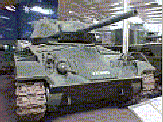
The US Light Tank M24 (Chaffee) named after General Adna R Chaffee, was designed began in mid 1943, in order to replace the M5A1 (Stuart) Light tank, which suffered from insufficient armour, lack of room in the turret and overheating of the engine. The first production vehicle appeared in April 1944. A small number reached Europe to take part in the Rhine crossing and the closing stages of the war, being used in a reconnaissance role.
The Chaffee was of conventional design, being powered by two Cadillac V-8 engines with Hydramatic transmission and torsion bar suspension. The turret mounted a M6 75mm gun, which was derived from a special aircraft cannon design.
Chaffee, Specification
|
Armament |
Armour |
Weight |
Length (m/ft in) |
Height (m/ft in) |
Powerplant |
Speed (Km/h/Mph) |
Crew |
|
1 x 75mm M6 plus 1 x 0.30-in and 1 0.50-in Machine Guns |
38 mm Max |
18.37 tonnes |
5.49/ 18ft |
2.47/ 8ft 1in |
2 x Cadillac 110-hp V-8, gasoline |
48/30, with a range of 160 km (100 Miles) |
5 |
| Chaffee Tank |
The Comet, of 1944-45, was the last of the 'cruiser' series and generally conceded to have been the best British wartime tank design. In late 1941 the General Staff asked the Tank Board for a cruiser tank mounting the most powerful possible gun, capable of defeating " any German tank. The first response to this was Challenger, a modified Cromwell chassis with a large turret carrying a 17-pdr gun. This was not particularly successful, and the Tank Board turned to the development for an alternative, a Cromwell chassis mounting a high-velocity 75-mm (2.95-in) gun.
 This
gun had been privately developed by Vickers-Armstrong as a 50-calibre weapon to
give 808 m/sec (2651 ft/sec) with a 7-kg (15-lb) shot. For the sake of
production convenience it was redesigned in 3.03-in (77-mm) calibre to take the
same projectile as the 17-pdr gun and to use the cartridge case of the latter,
the two components being married together and called the 77-mm (3.03-in) round.
The result was the 77-mm gun that was, in effect, a detuned 17-pdr, the
principal advantage being that the ammunition was smaller and the gun took up
less room.
This
gun had been privately developed by Vickers-Armstrong as a 50-calibre weapon to
give 808 m/sec (2651 ft/sec) with a 7-kg (15-lb) shot. For the sake of
production convenience it was redesigned in 3.03-in (77-mm) calibre to take the
same projectile as the 17-pdr gun and to use the cartridge case of the latter,
the two components being married together and called the 77-mm (3.03-in) round.
The result was the 77-mm gun that was, in effect, a detuned 17-pdr, the
principal advantage being that the ammunition was smaller and the gun took up
less room.
The Comet tank was thus based on the Cromwell hull, with extra armour, and had a wider turret ring to accept the larger turret with the bigger gun. The first production models were delivered in September 1944 and, after units had retrained, the tank was used in action for the first time in March 1945. Apart from some disappointment over the reduced armour-piercing capability of the gun when compared with the 17-pdr, the Comet was well-liked and soon built up a good reputation for reliability and speed.
The Comet was issued to 7th Armoured Division after the end of the Second World War, but did use them in the Berlin Victory Parade in July 1945.
After the war it became the principal British tank until replaced by the Centurion, a process which was completed in about 1950.
|
Armament |
Armour |
Weight |
Length (m/ft in) |
Height (m/ft in) |
Width (m/ft in) |
Powerplant |
Speed (Km/h/Mph) |
Crew |
|
1 x77-mm (3.03-in) plus 2x7.92-mm (0.312-in) BESA Machine Guns |
76-mm (3-in) hull, 102-mm (4-in) turret |
33.22 tonnes |
6.5539/ 21 ft 6 in |
2.673/ 8ft 9in |
3.073/ 10 ft 1 in |
Rolls-Royce V-12m 600 bhp |
51/32 |
5 |
| Comet Tank | |
It may seem strange to include information on a Machine Gun on a page all about Tanks, but the BESA Machine Gun was the mainstay of British Tanks 'secondary armourment' for all of the Second World War. In 1937 the British army began looking for an air-cooled replacement for the Vickers machine-gun for use in infantry battalions and in tanks, and the Czech ZB vz/53 (also called the vz/37) designed by Vaclav Hoiek was chosen. The original intention was to have it redesigned to take the rimmed .303-in (7.7-mm) cartridge, but time was short and it was decided to forgo its infantry application and adopt it for tank use only in its original 7.92-mm (0.312-in) chambering, which then required a supply of 7.92-mm ammunition. This was less of a disadvantage for tank use than it would have been had the weapon seen wider application. Arrangements were made to have the gun manufactured by the BSA Company under license, hence the name BESA. The first production guns were issued to the army late in 1939.
The BESA was a gas-operated gun with two unusual features. Firstly, the piston left the gas cylinder on its rearward stroke, so that the gasóand the powder foulingówere exhausted to the outside, giving a high degree of reliability. Secondly, the barrel recoiled within the gun body and the gun actually fired while the barrel was still returning to its forward position. This meant that the recoil force had to stop the forward movement before it could begin to force the barrel back again, and this, in turn, reduced the recoil force on the gun mounting. The original BESA (MK 1) had two rates of fire, 450 rounds per minute or 750 rounds per minute, achieved by varying the stroke of the bolt during recoil. In subsequent marks, which were designed with a view to simplifying production, this feature was removed and the gun fired at 750 rounds per minute only. The BESA MK 1 (as show below) is distinguished by the cooling fins and pierced barrel casing were removed in later marks.
As the war progressed a simplified version, the BESA MK 3, was produced, still retaining calibre of 7.92-mm (0.312-in), with changes to speed production and cut costs. When additional changes had been made to the MK 3 it was 20% cheaper than the original BESA MK 1 machine-gun. The original Czech gun, saw action throughout the world, and similar types of gun were mounted in the Czech tanks used by the Germans. A picture of the MK3 is shown below.

A scaled-up version of the gun in 15-mm calibre was also produced in relatively small numbers and used in armoured cars as their primary armament. Derived from the Czech ZB vz/60 heavy machine-gun developed in 1938, and known as the MG M38(t) 15-mm, it does not seem to have been very popular, though there was an abortive attempt, in 1944, to redesign it as a 20-mm cannon. The 15-mm BESA was declared obsolete in 1949; the 7.92-mm version remained in service until the late 1950s.
BESA Machine Gun, Data:
|
Model |
Calibre (in/mm) |
Weight (Unloaded) (kg/lb.) |
Length (cm/in) |
Barrel Length (mm/in) |
Magazine |
Rate of Fire |
Muzzle Velocity (m/s /ft/s) |
|
7.92 mm Mark I |
0.312/7.92 |
21.31/47 |
110/43.5 |
640/25.2 |
250 round belt |
450 or 750 |
822.9 /2700 |
|
15 mm Mark I |
0.590/15 |
56.69/125 |
205/80.75 |
640/25.2 |
25 round belt |
450 |
818.3 /2685 |
| BESA Machine Gun |
As with the BESA Machine Gun above, this is included on this page as it was used extensively in US supplied British tanks. The Browning M1919 A4 was an air-cooled version of the Browning M1917 developed during 1918, and produced from 1934, originally for tanks, as the A5 variant. For infantry use it was also provided with a short tripod so that it could be used outside the tank. Like the Browning M1917 it fired the 0.30 inch calibre US Service cartridge fed from a 250-round cloth belt system at a rate of fire of 500 rounds-per-minute. It remained in service with the British Army until the 1990's, serving in Royal Engineer ARVs in the First Gulf War. The pictures below show it on a tripod mount and without.
Browning 0.3 inch Machine Gun, Data:
|
Model |
Calibre (in/mm) |
Ammunition |
Weight (Unloaded) (kg/lb.) |
Length (cm/in) |
Barrel length (cm/in) |
Muzzle Velocity (m/s /ft/s) |
Rate of fire |
|
M1919 |
0.3/7.62 |
Cloth belt, 250 round units |
14.98/33 (Gun only) |
104/41 |
61/24 |
853/2800 |
500 |
| Browning 0.30" Machine Gun |
Divisional Equipment Page Armoured Cars Page Artillery Page Infantry Page Other Equipment Page